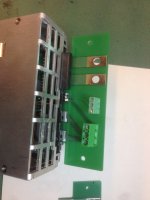Alan B
100 GW
Sorry to hear about the "rectifier" failure. That's a big loss. At least the one I have wasn't cheap, but I bought it new. There are some at better prices now.
I was involved with a number of safety systems (accelerator controls, X ray machines, etc), there are safety rated relays, and they tend to fail open if properly selected for the application. Regular solid state relays are generally not allowed in safety systems. They are SCR or FET based and they fail shorted. In most designs that doesn't fit the definition of a "fail safe component".
For a safety system generally two independent circuits and separate controls are required. Probably don't need to go quite that far here, but one could.
How did you determine the 3.3V was isolated? Do we have a schematic of the "rectifier" module?
This project will not be easy, is it worth the effort and risk? The Meanwell LED supplies are easier and very robust. Are you familiar with those? Their efficiency is high and they are adjustable in both CC and CV. The only thing you might want to add is end of charge disconnect.
I was involved with a number of safety systems (accelerator controls, X ray machines, etc), there are safety rated relays, and they tend to fail open if properly selected for the application. Regular solid state relays are generally not allowed in safety systems. They are SCR or FET based and they fail shorted. In most designs that doesn't fit the definition of a "fail safe component".
For a safety system generally two independent circuits and separate controls are required. Probably don't need to go quite that far here, but one could.
How did you determine the 3.3V was isolated? Do we have a schematic of the "rectifier" module?
This project will not be easy, is it worth the effort and risk? The Meanwell LED supplies are easier and very robust. Are you familiar with those? Their efficiency is high and they are adjustable in both CC and CV. The only thing you might want to add is end of charge disconnect.



